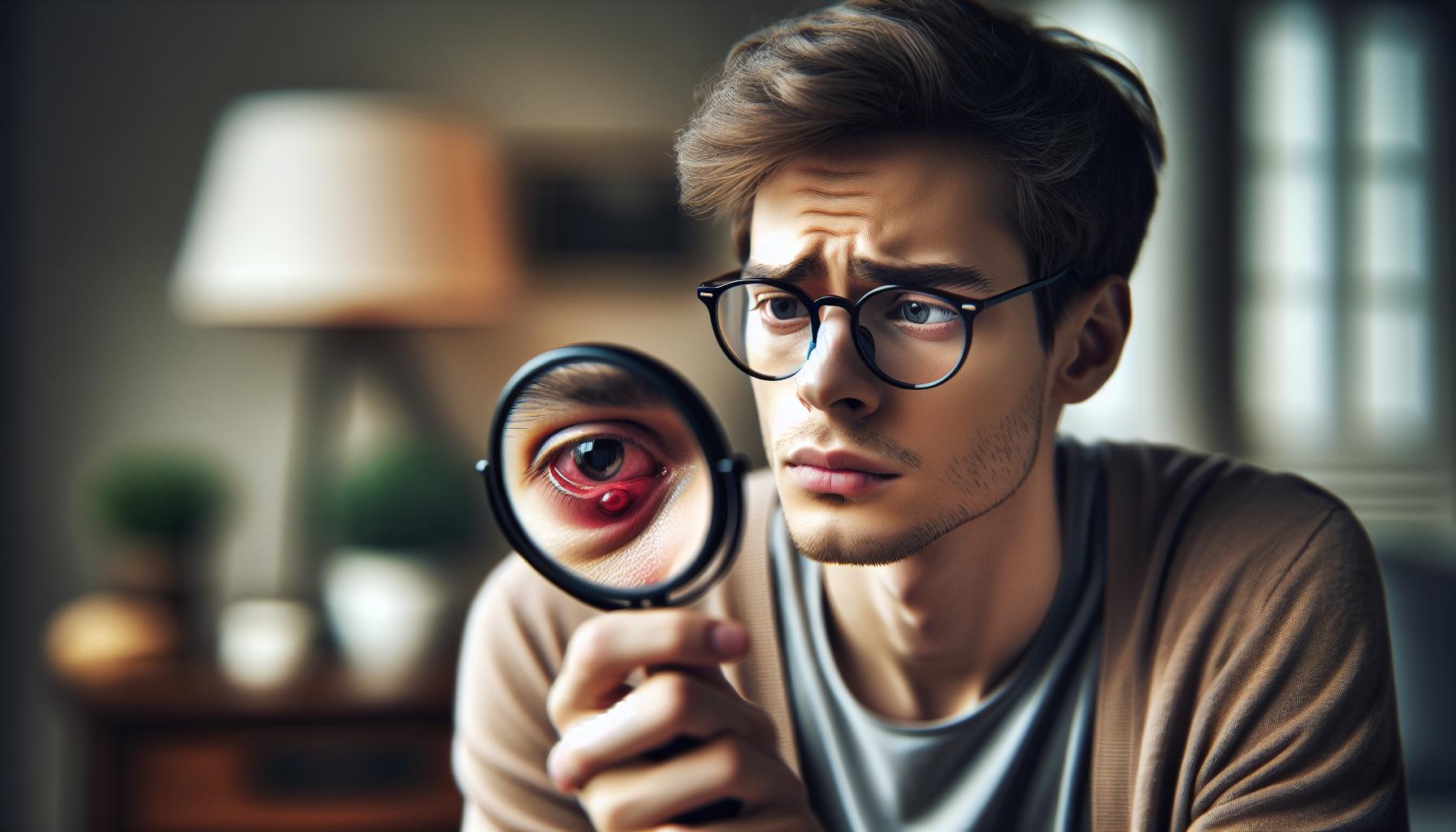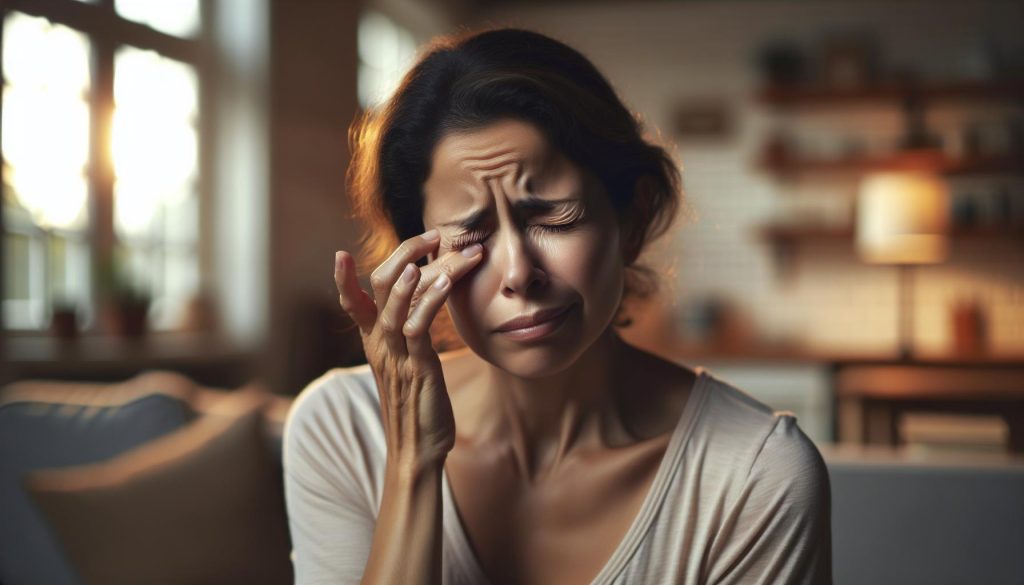An eye stye can be not only uncomfortable but also embarrassing, often appearing at the most inconvenient times. This small, painful bump on the eyelid can disrupt your daily routine and may leave you wondering how to find relief quickly. Exploring effective methods to get rid of a stye is essential for reclaiming your comfort and confidence.
In this article, we will outline five proven methods to hasten the healing process and alleviate discomfort. From tried-and-true home remedies like warm compresses to over-the-counter treatments, we’ll empower you with practical, research-backed solutions. Understanding how to treat a stye effectively will help you manage this common yet frustrating issue and enjoy clearer, healthier eyes again. Keep reading to discover the strategies that can bring you fast relief and restore your natural beauty.
How Eye Styes Form: Causes and Symptoms
A stye is often an unwelcome surprise-like an uninvited guest that shows up right before an important event. These painful, red bumps on the eyelids are generally caused by a bacterial infection in the oil glands of the eyelid, leading to inflammation and swelling. Understanding how styes form can empower you to take better care of your eye health and recognize the signs early.
The process begins when bacteria, usually Staphylococcus, enter through the opening of an oil gland, often due to poor hygiene or touching your eyes with unclean hands. This infection triggers the body’s immune response, causing redness, swelling, and tenderness around the affected area. Common symptoms include a painful, swollen lump on the eyelid, increased tear production, sensitivity to light, and a gritty sensation in the eye. Sometimes, there may be crusting or discharge, particularly if the stye is more severe.
To mitigate your risk of developing a stye, consider routine hygiene practices. Regularly wash your hands and avoid touching your face. It’s also beneficial to replace eye makeup frequently and not share cosmetics to minimize bacterial transfer. Recognizing these symptoms early can help you initiate treatment quickly, often before they escalate into something more uncomfortable.
Recognizing the Signs of an Eye Stye

Recognizing the early signs of an eye stye can make all the difference in treatment and comfort. When you notice a painful bump forming on the edge of your eyelid, it’s often accompanied by an array of distinctive symptoms. Initially, you may experience a sensation of tenderness or discomfort in the area. This is frequently followed by swelling, creating a lump that can resemble a pimple or boil. As the stye progresses, you might also encounter increased tear production, light sensitivity, and a gritty feeling in your eye, all indicative of irritation.
In some cases, styes can lead to more visible symptoms, such as redness surrounding the eye or even crusting along the eyelashes, especially after sleep. If you’re experiencing pus or discharge, which may accompany a severe stye, it’s crucial to monitor the situation carefully.
Key Signs to Look Out For
- Painful Swelling: A noticeable, tender bump on the eyelid.
- Redness: The skin around the stye often appears red and inflamed.
- Increased Tear Production: You may notice your eyes watering more than usual.
- Light Sensitivity: Discomfort in bright light can occur.
- Gritty Sensation: Many report a feeling akin to having sand in the eye.
- Crusting or Discharge: Pus may develop, particularly in more severe cases.
Timely recognition of these symptoms prompts quicker intervention, which can reduce pain and expedite healing. As soon as you notice these signs, you may consider applying warm compresses to the area to alleviate discomfort and promote drainage, while being mindful of the state of your overall eye hygiene. These proactive steps can help in managing a stye effectively before it escalates.
Effective Home Remedies for Quick Relief

Applying warm compresses is one of the simplest and most effective home remedies for quickly providing relief from an eye stye. By using a clean cloth soaked in warm (not hot) water, you can gently press the compress against the affected eyelid for 10-15 minutes several times a day. This method helps to soothe irritation, reduce swelling, and encourages the stye to drain naturally. The warmth enhances blood circulation in the area, promoting healing while alleviating discomfort.
In addition to warm compresses, maintaining high levels of hydration can significantly influence your recovery. Drinking plenty of water helps flush out toxins from your body and supports overall eye health. Integrating foods rich in antioxidants, such as blueberries and leafy greens, can also bolster your immune response, potentially aiding your body in fighting off the infection causing the stye.
Another handy remedy is using chamomile tea bags. Steep two tea bags in hot water, allow them to cool until warm, and then place them over your eyes. Chamomile is known for its soothing properties and may help reduce inflammation and relieve irritation. Just ensure that the tea bags are sufficiently cool to avoid burns.
Finally, it’s important to avoid squeezing or attempting to pop the stye, as this could lead to further infection or complications. Instead, focus on these gentle yet effective remedies that not only relieve discomfort but also support a healthy recovery, keeping your eyes bright and clear.
Over-the-Counter Treatments: What Works Best?

When facing the discomfort of an eye stye, many wonder about the various over-the-counter options available to relieve symptoms and speed up recovery. Fortunately, there are several effective treatments that can be easily found at your local pharmacy, which can help alleviate pain and promote healing without prescription medications.
One of the first lines of defense against a stye is the use of topical antibiotic ointments. These can be effective at combating any bacterial infection around the eyelid. Brands containing bacitracin or neomycin are commonly used; apply them to the affected area following the instructions provided. However, caution is advised: avoid applying the ointment directly inside the eye and be sure to wash your hands before and after application to prevent further irritation or spreading the bacteria.
Additionally, anti-inflammatory over-the-counter medications such as ibuprofen or naproxen can help reduce pain and swelling associated with a stye. These can be taken according to the dosing instructions on the package and typically offer relief in a relatively short period.
For those experiencing persistent symptoms, eye drops that contain antihistamines may alleviate discomfort, especially if allergies are contributing to the irritation. These drops help reduce redness and puffiness and can be a soothing addition to your eye care routine.
If you are frequently prone to styes, consider investing in eyelid scrubs that specifically target the buildup of oils and debris that can lead to blockages. These are available in pre-moistened pads and can be used daily to maintain eye hygiene and prevent future occurrences.
It’s essential to monitor your symptoms and, should your stye fail to improve or worsen after using these over-the-counter treatments, to consult a healthcare professional. They may prescribe stronger medications or explore other interventions to ensure your eyes remain healthy and irritation-free.
When to Seek Medical Attention for an Eye Stye

Experiencing an eye stye can be frustrating and uncomfortable, but recognizing when it’s time to seek medical attention is crucial for your overall eye health. While most styes resolve on their own within a week or two, there are specific signs to watch for that may indicate a need for professional intervention. If you notice that the stye is not only persisting but also enlarging, it could be a signal that the infection is worsening or that you may have a chalazion, which requires different treatment.
Another important factor is the level of discomfort you’re experiencing. If the stye is causing significant pain, swelling, or redness that spreads beyond the eyelid, consulting a healthcare provider is advisable. This can help prevent complications such as the risk of the infection spreading to other areas of your eye, leading to more severe issues. Additionally, if your vision is affected in any way-such as experiencing blurriness or light sensitivity-don’t hesitate to seek immediate care.
It’s also wise to look out for other symptoms that might suggest a more serious condition, such as fever or persistent drainage from the eye, which could indicate an underlying infection needing urgent attention. If you have underlying health conditions such as diabetes or if the styes are recurrent, these circumstances may further warrant a professional assessment to determine an appropriate treatment plan.
In summary, while mild styes often resolve without intervention, don’t ignore troubling symptoms. Listening to your body and being proactive in seeking medical advice can help ensure that your eye health remains a priority. Remember, it’s always better to err on the side of caution when it comes to your vision and comfort.
Preventive Measures: Avoiding Future Eye Styes
Taking proactive steps to prevent eye styes can make a significant difference in your eye health and overall comfort. A stye is not only painful but can also impact your daily activities. The good news is that many effective strategies can help you avoid these irritating bumps on your eyelids.
One of the most critical preventive measures is to maintain excellent eyelid hygiene. Gently cleanse your eyelids daily with a mild soap or baby shampoo diluted in water. This practice can help remove excess oils and debris that may clog your glands, reducing the likelihood of stye development. Additionally, remember to wash your hands frequently and avoid touching your eyes. This simple habit minimizes the risk of transferring bacteria to your eyelid area.
Furthermore, being vigilant about your makeup routine can also help. Avoid using eye makeup, especially eyeliner and mascara, when you have a stye or feel one coming on. Always remove your makeup before bed, and consider replacing makeup products regularly to prevent bacterial buildup. If you frequently develop styes, you might want to limit the use of eye makeup altogether and opt for hypoallergenic products that reduce the risk of irritation.
Stress management plays a surprising role in maintaining eye health, so incorporating relaxation techniques such as yoga or mindfulness can benefit not only your mental well-being but also your physical health. When stress levels are manageable, your body is better equipped to fend off infections, including styes.
Lastly, consider your diet. A well-balanced diet rich in fruits, vegetables, and omega-3 fatty acids supports overall health and can strengthen your immune system, helping to prevent various ailments, including styes. Regular hydration is equally important, as it helps maintain the moisture balance necessary for healthy eyes.
By implementing these practical strategies, you can significantly reduce the chances of recurrent styes and enjoy healthier, more comfortable eyes. Remember, small lifestyle changes can yield significant results in your eye health journey.
Natural Remedies: Herbal and Essential Oil Solutions
There are several natural remedies that can effectively soothe the discomfort of an eye stye and promote healing. Utilizing herbal and essential oil solutions can be a gentle yet powerful addition to your eye care routine. For instance, chamomile tea bags, after being cooled, can serve as a warm compress applied to the affected eye. Chamomile is renowned for its anti-inflammatory and antibacterial properties, which help reduce swelling and irritation. Simply steep two tea bags in hot water, let them cool, and apply them to your eyelids for about 10-15 minutes.
Another excellent natural remedy is using calendula oil. Known for its healing properties, calendula can be beneficial for easing the symptoms associated with styes. You can create a soothing salve by mixing a few drops of calendula oil with a carrier oil, such as coconut or olive oil. Apply this mixture gently around the stye (but avoid direct application on the stye itself) to help reduce inflammation and promote healing.
Essential oils also play a significant role in treating styes. Tea tree oil is particularly praised for its antimicrobial properties. However, it must be used with caution. Dilute one drop of tea tree oil in a teaspoon of carrier oil and apply it gently around the stye area to combat bacteria while minimizing irritation. Remember to do a patch test on your skin first to ensure there’s no allergic reaction.
Lastly, incorporating lavender oil into your routine can help as well; its calming scent can reduce stress and promote relaxation, which is beneficial in preventing styes that may be triggered by stress. You can diffuse lavender oil in your home or add a few drops to your pillow to enjoy its calming effects.
Using these herbal and essential oil solutions not only aids in the treatment of styes but also empowers you to take charge of your eye care. Always remember to consult a healthcare professional if symptoms persist or worsen.
Understanding the Role of Hygiene in Eye Care
Maintaining proper hygiene is paramount when it comes to eye care and preventing conditions like styes. Did you know that many styes are often linked to bacteria on your eyelids that can result from poor hygiene? Simple daily practices can significantly reduce the risk of developing styes while promoting overall eye health.
Start with washing your hands before touching your face or eyes. Regular handwashing is your first line of defense against transferring harmful bacteria. Always use a gentle, hypoallergenic soap to ensure your skin remains irritant-free. After washing your hands, be mindful when removing eye makeup; utilize a soft, lint-free cloth or cotton pad soaked in a gentle makeup remover to carefully cleanse your eyelids. This not only removes makeup residue but also helps eliminate any lurking bacteria.
Incorporating a consistent eyelid cleansing routine can make a profound difference. Using eyelid wipes specifically designed to cleanse the delicate skin around your eyes helps remove dirt, oil, and debris that can contribute to styes. These wipes can be easily integrated into your nightly skincare routine. Also, remember to avoid sharing personal items like towels, makeup brushes, or anything that comes into contact with your eyes, as these can easily harbor bacteria.
Finally, if you wear contact lenses, prioritize keeping them clean by following proper lens care practices. Ensure that you replace your lenses as recommended and always sanitize your lens case. By combining these hygiene practices with awareness of your eye care routine, you empower yourself to minimize the risk of developing styes and experience clearer, healthier eyes.
The Connection Between Eye Styes and Allergies
Hay fever and other allergic reactions can leave your eyes feeling itchy, irritated, and prone to discomfort, including the unsightly presence of eye styes. These eyelid bumps, often caused by bacterial infections in blocked oil glands, can be exacerbated by the environmental factors related to allergies. When you rub or touch your eyes to relieve the itchiness caused by allergens like pollen, you increase the risk of introducing bacteria that can lead to a stye.
Moreover, when the body reacts to allergens, it tends to produce more mucus and can block tear glands, contributing to inflammation around the eyes. This inflammation may create a perfect breeding ground for bacteria, further increasing the chances of developing styes. To mitigate these issues, it’s important to adopt a proactive approach to eye health during allergy season. This includes frequent handwashing and avoiding touching your face as much as possible.
In addition, regular cleansing of the eyelids can help remove allergens and bacteria that irritate the skin and lead to infection. Consider using eyelid wipes specifically designed for sensitive skin, as they can effectively clean away debris and reduce your risk of styes while soothing the eye area. Simple lifestyle modifications, such as managing your allergy symptoms with antihistamines, can also play a significant role in reducing your likelihood of flare-ups and subsequent stye formation.
Addressing Eye Styes in Children: Special Considerations
Understanding how to care for children’s eye health is crucial, especially when dealing with pesky eye styes. These small, painful lumps on the eyelid can distress both children and their parents. It’s important to remember that children’s immune systems are still developing, making them more susceptible to infections, including those that cause styes. Ensuring proper hygiene is the most effective way to help prevent styes from forming in the first place.
Start by teaching your child about the importance of keeping their hands clean. Frequent handwashing, especially before touching their eyes or face, can significantly reduce the risk of transferring bacteria that may lead to a stye. In addition, remind them to avoid rubbing their eyes, particularly after playing outdoors or during allergy seasons when they may feel itchy. Establishing a routine of regular eyelid cleansing can also help; using warm, damp washcloths can soothe irritation and remove bacteria.
When a stye does occur, the most comforting remedy is often a warm compress applied to the affected area. A simple method involves soaking a clean cloth in warm water, wringing it out, and gently pressing it against the closed eyelid for 10-15 minutes, a few times a day. This can help reduce pain and promote drainage if the stye is ready to burst. However, always avoid squeezing or popping the stye, as this might lead to further infection or complications.
In instances where your child’s stye does not improve with home care after several days, or if they experience increased redness, swelling, or pain, consult a pediatrician or an eye specialist. They can provide safe, effective treatments tailored for children, which may include antibiotic ointments or other interventions. Empowering your child with knowledge, combined with vigilant care from parents, can enhance their comfort and promote a swift recovery.
The Impact of Diet on Eye Health and Stye Prevention
Diet plays a significant role in maintaining eye health and can be a key factor in preventing styes. Research suggests that certain nutrients are especially beneficial for keeping your eyes healthy and resilient against infections. For instance, incorporating antioxidant-rich foods into your diet can help bolster your immune system, making it more effective at fighting off the bacteria that can lead to styes.
Foods high in vitamins A, C, and E, as well as zinc, can support your ocular health. Carrots, bell peppers, spinach, and nuts are excellent choices that not only benefit your overall health but also enhance your eye’s ability to fend off infections. Omega-3 fatty acids, found in fatty fish like salmon and flaxseeds, are known to support tear production and maintain moisture in the eyes, which is vital in preventing dry eyes-a condition that can contribute to stye formation.
Moreover, it’s crucial to be mindful of the potential link between diet and inflammation. Foods high in sugar and unhealthy fats can lead to spikes in inflammation throughout the body, including in the eyes, which could increase susceptibility to styes and other conditions. A balanced diet that consists of whole grains, lean proteins, and plenty of fruits and vegetables can help keep inflammation in check, ultimately fostering a healthy environment for your eyes.
In addition to selecting the right foods, staying hydrated is essential. Water helps to maintain the overall health of your skin and ensures that your eyes stay properly lubricated. Aim to drink plenty of water throughout the day, and consider reducing caffeine and alcohol intake as they can lead to dehydration. Adopting such dietary habits can be a proactive way to lower your risk of eye styes and promote long-term eye health.
Expert Tips for Eye Care During Makeup Application
Applying makeup can be a wonderful way to express yourself, but it’s essential to prioritize eye health, especially when dealing with conditions like styes. These small, painful lumps can be aggravated by the products we use, making it vital to adopt careful makeup habits. By following some straightforward tips, you can enjoy your beauty routine without compromising your ocular health.
Start with a clean slate. Before applying any makeup, ensure your hands are clean and that you have a fresh makeup palette. This helps to minimize the introduction of bacteria that can lead to styes or further irritate existing ones. Consider using a gentle eye makeup remover to clean your eyelids thoroughly at the end of the day; this can prevent residue buildup that clogs oil glands and contributes to stye formation.
When choosing products, opt for hypoallergenic and non-comedogenic makeup formulations. These types of products are less likely to irritate the skin or cause blockage in the eyelid’s oil glands. Pay special attention to mascara and eyeliner; ensure they are fresh and replace them every three months to reduce the risk of bacterial contamination. Furthermore, avoid using makeup testers at stores, as they can harbor germs that contribute to eye infections.
Application technique matters too. Always use clean brushes and applicators when applying makeup to your eyes. If you’re using gel or liquid liners, consider using a brush instead of the applicator to minimize direct contact with your eyelids. One helpful tip is to use a new coat of mascara each time rather than layering on old product. Layers of dried product can irritate the eyes and increase the risk of styes. Lastly, remember to remove your makeup thoroughly every night, especially eye makeup, to keep your eyelids clean and free from clogs.
By being mindful of hygiene and product choices, you can enjoy your makeup while still caring for your eye health, ensuring you look and feel your best without the discomfort of styes.
Frequently asked questions
Q: What are the fastest home remedies to treat an eye stye?
A: The quickest home remedies include warm compresses applied several times a day to soothe inflammation, tea bag compresses (like green tea) that may reduce swelling, and gentle eyelid scrubs with diluted baby shampoo to maintain hygiene. These methods can help alleviate discomfort and promote healing.
Q: How long does it take for a stye to go away on its own?
A: A stye typically resolves on its own within 5 to 7 days. However, using warm compresses and practicing good hygiene can speed up the healing process. If symptoms persist beyond this period, consult a healthcare professional for further advice.
Q: Can I pop a stye to get rid of it faster?
A: No, popping a stye is not recommended as it can lead to further infection and worsen symptoms. Instead, stick to safe home remedies and hygiene practices. If discomfort persists, seek medical advice for appropriate treatment options.
Q: Are there effective over-the-counter products for treating styes?
A: Over-the-counter treatments such as antibiotic ointments or eyelid wipes specifically designed for styes can be effective. Look for products containing ingredients like bacitracin or polymyxin B, but consult your healthcare provider for recommendations suitable for your situation.
Q: When should I see a doctor about a stye?
A: You should see a doctor if the stye doesn’t improve after a week of home treatment, if it is causing significant pain or vision problems, or if you experience recurring sties. Persistent symptoms may need medical attention to prevent complications.
Q: Can stress or a poor diet contribute to the formation of styes?
A: Yes, stress and a poor diet can affect overall health and immune function, potentially leading to the development of styes. A balanced diet rich in vitamins and regular stress management techniques can help maintain better eye health.
Q: How can I prevent future styes from forming?
A: To prevent future styes, maintain good eyelid hygiene, avoid sharing towels or makeup, and remove eye makeup thoroughly before bed. Regularly washing your hands and managing any skin conditions can also reduce the risk of developing styes.
Q: Is there a link between allergies and styes?
A: Yes, allergies can lead to eye irritation and rubbing, increasing the risk of developing styes. Managing allergies with appropriate medication and avoiding allergens can help minimize the occurrence of styes.
To Conclude
Taking swift action against a stye is essential for relief and healing. Remember, applying warm compresses and maintaining good eyelid hygiene are effective first steps. If symptoms persist or worsen, don’t hesitate to consult an eye care professional to ensure the best treatment options, such as medicated ointments or lancing if necessary. For more insights, check out our articles on preventing styes and managing other common eye conditions.
Want to stay informed about eye health? Sign up for our newsletter for expert tips and exclusive content tailored to your needs. If you found this guide helpful, consider sharing it with friends or family who might benefit, and explore our other resources for comprehensive skincare and health information that empowers you to take charge of your well-being. Don’t let a stye slow you down-act now for a quick recovery!




